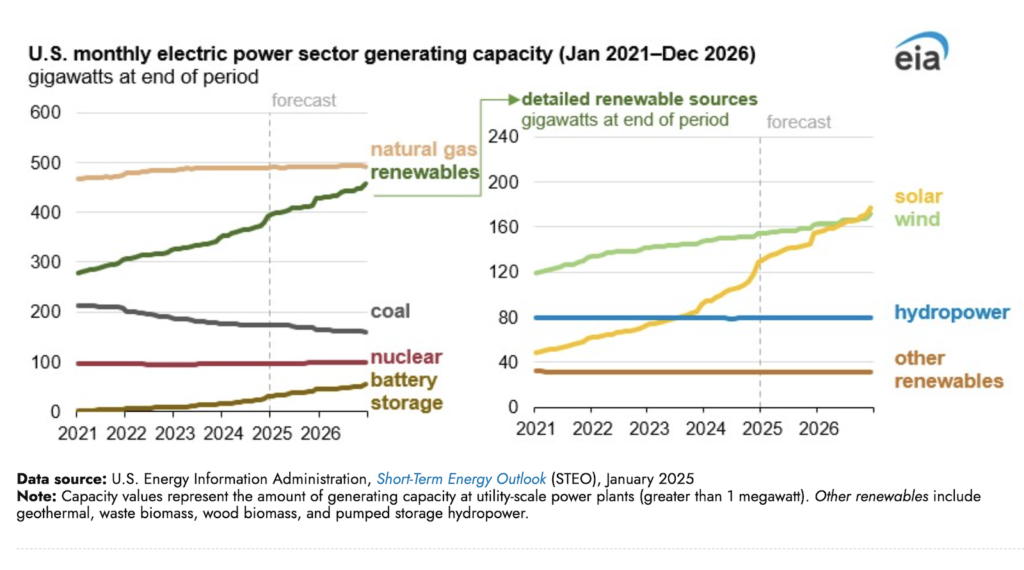
Sign up for daily news updates from CleanTechnica on email. Or follow us on Google News!

In our latest Short-Term Energy Outlook (STEO), we expect that U.S. renewable capacity additions—especially solar—will continue to drive the growth of U.S. power generation over the next two years. We expect U.S. utilities and independent power producers will add 26 gigawatts (GW) of solar capacity to the U.S. electric power sector in 2025 and 22 GW in 2026. Last year, the electric power sector added a record 37 GW of solar power capacity to the electric power sector, almost double 2023 solar capacity additions. We forecast wind capacity additions will increase by around 8 GW in 2025 and 9 GW in 2026, slight increases from the 7 GW added in 2024.
In contrast to solar and wind, generating capacity for most other energy sources will remain mostly unchanged in 2025 and 2026. Natural gas-fired capacity growth slowed in 2024, with only 1 GW of capacity added to the power mix, but natural gas remains the largest source of U.S. power generation.
We forecast U.S. coal retirements will accelerate, removing 6% (11 GW) of coal generating capacity from the U.S. electricity sector in 2025 and removing another 2% (4 GW) in 2026. Last year, coal retirements represented about 3 GW of electric power capacity removed from the power system, which is the lowest annual amount of coal capacity retired since 2011.

We expect that planned renewable capacity additions will support most of the growth in U.S. electric power generation, which we expect will increase by 2% in 2025 and by 1% in 2026. The U.S. electric power sector produced a total of 4,155 billion kilowatthours (kWh) of electricity in 2024, up 3% from 2023.
Natural gas
In 2024, U.S. natural gas-fired power plants generated a total of 1,767 billion kWh, 4% more than in 2023. Natural gas-fired power accounted for around 42% of the U.S. electricity mix, mostly unchanged compared with 2023. We expect natural gas generation will decline in 2025 by 3% to 1,712 billion kWh and decrease a further 1% to 1,692 billion kWh in 2026.
Renewables
We expect renewable power generation will increase 12% in the United States to 1,058 billion kWh in 2025 and increase a further 8% to 1,138 billion kWh in 2026. Renewable sources were the second-largest contributor to U.S. power generation in 2024 and accounted for 945 billion kWh, up 9% from 2023.
Nuclear
We expect U.S. nuclear power generation to grow 2% to 796 billion kWh in 2025 and increase a further 1% to 800 billion kWh in 2026. Nuclear power generation in 2024 was up slightly from 2023, totaling 781 billion kWh. Increased nuclear generation in the forecast is partly due to the addition of the two Vogtle power plant units that began commercial operations in July 2023 and April 2024, as well as the expected restart of the Palisades power plant in October 2025.
Coal
We expect U.S. coal power generation to remain unchanged at around 640 billion kWh in 2025 and 2026. Coal electricity generation was 647 billion kWh in 2024.
Principal contributor: Katherine Antonio. First published on Today in Energy.
Chip in a few dollars a month to help support independent cleantech coverage that helps to accelerate the cleantech revolution!
Have a tip for CleanTechnica? Want to advertise? Want to suggest a guest for our CleanTech Talk podcast? Contact us here.
Sign up for our daily newsletter for 15 new cleantech stories a day. Or sign up for our weekly one if daily is too frequent.
CleanTechnica uses affiliate links. See our policy here.
CleanTechnica’s Comment Policy

